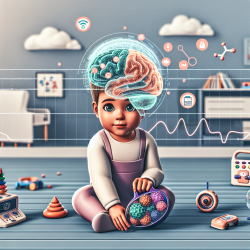In the realm of speech-language pathology, continuous learning and application of research findings are crucial for effective practice. The study titled "Language, Speech and Reading Disorders in Children: Neuropsychological Studies" provides invaluable insights for practitioners aiming to refine their skills and strategies when working with children facing these challenges. This comprehensive overview of a major research project sheds light on the mechanisms underlying specific communication disorders, offering a path toward more targeted and effective interventions.
The research focuses on children with developmental disorders in language, speech, and reading, who do not have obvious neurological or physical impairments. It aims to uncover the "natural puzzle" of the underlying causes of these disorders, presenting an opportunity for practitioners to deepen their understanding and enhance their approach to treatment.
Key Findings and Implications for Practice:
- Temporal Processing Deficit Hypothesis: The research supports the hypothesis that deficits in processing information rapidly in time underlie communication impairments. This insight is particularly relevant for speech-language pathologists (SLPs) as it emphasizes the importance of assessing and addressing temporal processing abilities in children with communication disorders.
- Patterns of Deficit: The study found distinct patterns of deficit among groups of children with specific language impairments, articulation impairments, and reading impairments. For practitioners, this underscores the necessity of tailored assessment and intervention strategies that consider the unique profiles of deficits in each child.
- Neural Timing Deficit in Language-Impaired Children: One of the most significant findings was the evidence of a basic neural timing deficit specifically in children with language impairments. This discovery opens new avenues for SLPs to explore interventions that target neural timing and processing speed, potentially leading to more effective outcomes for this population.
Practical Applications:
The research findings offer a wealth of knowledge that can be translated into practical applications for speech-language pathologists. Here are some ways practitioners can implement these outcomes:
- Integrating assessments that specifically evaluate temporal processing abilities in children suspected of having communication disorders.
- Developing intervention strategies that focus on improving processing speed and timing, such as rhythmic exercises or time-based auditory training.
- Customizing therapy plans to address the distinct patterns of deficits identified in the research, ensuring that each child's unique needs are met.
- Staying informed about ongoing research in neuropsychology and its implications for speech-language pathology to continuously refine and update intervention methods.
Encouragement for Further Research:
While the study provides significant insights, it also highlights the need for further research to explore the complexities of communication disorders. Practitioners are encouraged to engage with current research, participate in studies, and contribute to the growing body of knowledge in the field. This ongoing engagement with research not only enhances clinical practice but also supports the development of more effective interventions for children with language, speech, and reading disorders.
In conclusion, "Language, Speech and Reading Disorders in Children: Neuropsychological Studies" offers valuable guidance for speech-language pathologists seeking to enhance their practice. By understanding the neuropsychological mechanisms underlying communication disorders, practitioners can develop more targeted and effective intervention strategies. This research underscores the importance of integrating scientific findings into clinical practice, paving the way for improved outcomes for children with communication disorders.
To read the original research paper, please follow this link: Language, Speech and Reading Disorders in Children: Neuropsychological Studies.










